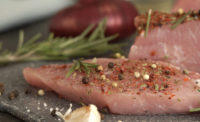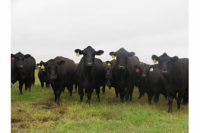Marinating meat and poultry is a key way to boost retailer revenues. A large base of consumers is willing to pay more for the value-added selections that typically are more flavorful, juicy and tender than conventional proteins.
Yet, adding marinades to meats also comes at a potentially high cost: the prospect of compromising food safety by spreading pathogens during the injection process.
While many plants have systems that are intended to minimize incidents, the threat of foodborne illness remains an operational hazard.
“There are clear flavor and quality benefits from marinating products, but like anything else, there also are tradeoffs,” says Don Schaffner, professor of food microbiology in the department of food science at Rutgers University, in New Brunswick, N.J. “That includes the chance of foodborne disease outbreaks that can occur when companies do not manage the marinating process efficiently.”
Contamination can ensue when plants introduce pathogens from the surface of a cut to the interior during injection. While most meat-sector operators are vigilant in guarding against such incidents, risks remain, he notes.
“All it takes is one company that is not up to speed on the issue and there can be an outbreak,” Schaffner says, adding that the publicity from an occurrence can affect sales throughout the industry.
Indeed, with the threat of Listeria, Salmonella and E. coli contamination ever-present in raw meat plants, it is crucial for operators to leverage sanitizing procedures that can help prevent even isolated events.
Measures can include periodically changing out marinades from tanks, regularly taking apart and cleaning all injection equipment components and injecting liquids through hollow needles, he says.
Coming soon: safety rules
New federal labeling requirements for raw or partially cooked beef products that have been mechanically tenderized also are intended to enhance safety.
The mandates by the U.S. Department of Agriculture’s Food Safety and Inspection Service (FSIS), which are set to take effect in May 2016, require labels to feature the product name and, if relevant, such designations as “mechanically tenderized,” “blade tenderized” or “needle tenderized.”
In addition, the labels of raw and partially cooked needle- or blade-tenderized beef products destined for household consumers, hotels, restaurants or similar institutions must have cooking instructions that specify the minimum internal temperatures and any hold or ‘‘dwell’’ times to help ensure the proteins are fully cooked to kill pathogenic bacteria that transfer to the interior of meat during mechanical tenderization.
The requirements also pertain to beef products injected with a marinade or solution unless the products are to be fully cooked or to receive another full lethality treatment at an official establishment.
Such rules are important because there are perpetual food safety threats from injecting solutions into meats, Schaffner says.
“The industry is always potentially tainted by the weakest food safety operator in the space,” he says. “Companies regularly need to ask themselves if they are doing the best they can to keep up to date with the latest scientific results on threats and safeguards. Plants can’t rest on their laurels. They must always do better with food safety.”
Equipment manufacturers, meanwhile, also are moving to combat pathogens by developing machines designed to simplify and enhance sanitation. Efforts include the launch of injection systems that enable users to more easily remove injection heads — which often contain 800 to 1,000 needles — for comprehensive cleanings, says Christine Alvarado, associate professor in the department of poultry science at Texas A&M University in College Station.
The ease of separation allows plants to readily place the head into a cleaning machine instead of individually treating each needle, she says, adding that “the procedure saves time and money and results in better soap dispersion.”
Downtime is a downer
While it is essential for plants to disassemble and thoroughly sanitize the manifold head and all the attached needles to minimize risks, such maintenance must be done in a fast and efficient manner to decrease production downtime, says Wes Osburn, associate professor in the department of animal science at Texas A&M University.
Operational delays also can occur as plants swap out needles for specific species and cuts. Switching from beef to pork, for instance, often requires altering the needle pattern while making adjustments to tip pressure and the amount of marinades and brines an item receives.
While it is common to sanitize injection systems at the end of shifts, Osburn says it also is sometimes crucial to clean machinery during production. This may be required when converting from allergen to non-allergen solutions in order to eliminate potentially harmful residues, and after the use of marinades with high viscosity, which can clog needles.
Solutions that recirculate back into the brine tank from a protein also can block needles and create bacterial growth, he says.
“It is important to take equipment apart quickly and swiftly flush cleaning solution through the entire system to reduce the halt in production, particularly during the mid-shift cleanup,” Osburn says.
Newer injecting equipment, meanwhile, will likely become even easier to sanitize, he adds, noting, for instance, that such machines will have more rounded corners to help reduce the prospect of bacteria forming in niches.
Yet, despite the inherent food safety risks, the benefits from producing and merchandising cuts with marinades far outweigh the possible hazards because of the quality, yield and taste enhancements, says J. Byron Williams, associate extension research professor in the department of food science, nutrition and health promotion at Mississippi State University, in Starkville.
In addition to the equipment sanitizing measures, plants also can effectively reduce the threat of foodborne illness by including natural and synthetic inhibitors in marinades, such as acetic acid, dry vinegar, sodium lactate and potassium lactate, he says. Salt, while also an inhibitor, is less desirable because of consumer health concerns.
Using antimicrobial dips, sprays and rinses on the surface of proteins also helps prevent contamination. But even with such efforts, most cuts will never be completely sterile, Williams says.
Nevertheless, he notes gains from injecting marinades are “tremendous. The color uniformity makes products more attractive to consumers and the eating quality is stronger because the meats are more juicy and tender. The greater yields from marinating also can enhance revenues.”
Round and round they go
Along with expanding their safety initiatives, many plants also bolster meat quality by placing injected cuts in tumblers to more effectively promote absorption of solutions.
Such operators include Tyson Fresh Meats Inc., a Dakota Dunes, S.D.-based-supplier of premium beef, pork and chicken, which tumbles to ensure marinades distribute equally throughout a cut, says Paul Connor, Tyson Fresh Meats director of value added business development.
Tyson, which produces the Crafted Creations line of marinated proteins, in some instances will even eschew injections and only use tumblers for marinating if it is seeking a specific “end experience,” he states.
Some plants that tenderize thin cuts of meat are able to generate acceptable levels of marinades by tumbling, Alvarado says.
Tumbling, meanwhile, can further improve product quality as it solubilizes some of the actin and myosin proteins in cuts and extracts the elements to the surface of the muscle fibers where they can help bind the marinades, Williams says.
The proteins also act as a natural glue to bind muscles back together when stuffed or shaped into a form or mold. If done properly, a product that is made of multiple muscles or pieces — such as a boneless ham and chunked and formed roast beef — will resemble a whole muscle, Williams says.
Tumbling also can enhance a product’s appearance and condition by eliminating needle holes and enabling better retention of marinades, Alvarado says.
Unlike the food safety risks from injecting marinades into beef and pork, there are fewer health threats when tenderizing poultry because all users typically fully cook the protein, she says.
A bigger concern, Alvarado says, is ensuring the proper amounts of salt and phosphates are put in the marinades to maintain product quality.
Correctly mixing additives into marinades also is imperative, says Casey Owens, associate professor in the department of poultry science at the University of Arkansas in Fayetteville.
“Ingredients that are added in the wrong order — such as by dissolving salt first instead of sodium phosphate or not giving the elements enough time to dissolve — will not be functional,” she says, noting it also is important to not over-add or under-add ingredients in order to maintain the proper taste.
Consistency is the key
For long-term customer satisfaction, plants need to focus on consistently maintaining the optimal marinade formulations and ensure operators always inject the proper amount of solution into each cut, Osburn says.
Newer technologies with computer controls, meanwhile, help standardize the procedures, he says. Such equipment makes it easier for operators to pinpoint the optimal pump pressure and belt speed when injecting cuts of different sizes and shapes and to store the parameters in a database.
More complicated is the need for product developers to meet the growing consumer demand for proteins with lower sodium levels while also ensuring such cuts maintain an attractive appearance.
Reducing salt and phosphates in marinades, for instance, can impact the ability of the elements to bind muscle proteins. The result can be greater leakage of solution and a reduction in yield.
“The clean-label issue is not going away,” Osburn says. “So there will be a continuous need to find ways to hold marinades in products so they don’t purge out in packages and become unappealing to consumers.”
Despite such quality, health and safety issues, meats with marinades are becoming increasingly attractive for both time-starved and cooking-challenged consumers willing to pay more for convenient value-added proteins, and retailers seeking to differentiate offerings from competitors’ and generate added revenues, says Kent Harrison, Tyson Fresh Meats vice president of marketing and premium programs.
“Marinating is an exciting area and one of the small, but exponentially growing, categories,” he says. “With such growth come a lot of opportunities.”
Injecting proteins with marinades is creating more attractive and appetizing meat and poultry products.
While potential food safety hazards are an ongoing risk, the benefits from merchandising the high-margin proteins is set to keep the category active and result in continuing enhancements to technologies and operating procedures. NP











